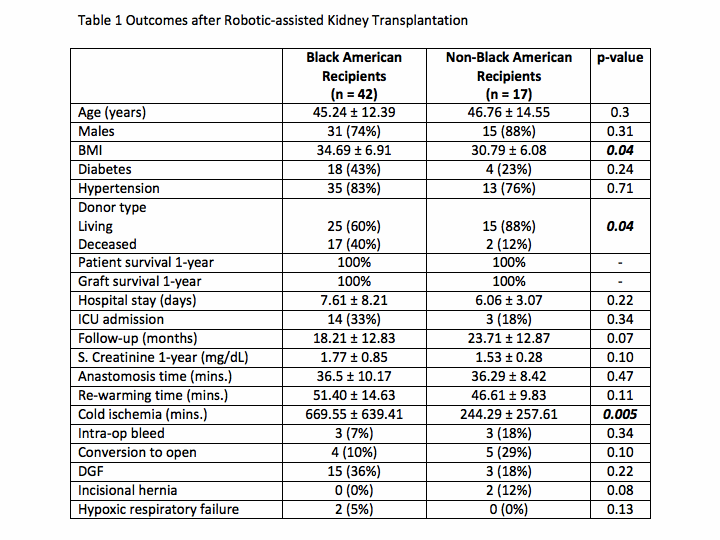Robotic-assisted kidney transplantation (RAKT) in obese black Americans (BA) recipients: evidence of healthcare equity
Amit Sharma1, Deki Tsering1, Daisuke Imai 1, Mehdi Eslami 1, Yuzuru Sambommatsu1, Dhiren Kumar1, Gaurav Gupta1, Chandra Bhati 2, Marlon Levy1.
1Hume-Lee Transplant Center, Virginia Commonwealth University, Richmond, VA, United States; 2Division of Transplantation Surgery, University of Maryland, Baltimore, MD, United States
Introduction: Morbidly obese patients with ESRD, including Black Americans (BA), may be denied access to life-saving kidney transplant (KT) due perceived higher risk of complications. Robotic-assisted KT (RAKT) is becoming our standard for transplantation in morbidly obese recipients (BMI >40) and is being expanded to the obese population (BMI >30). Our kidney transplant population is > 60% BA. With the current particular focus on health equity, we sought to compare the outcomes of RAKT between BA and non-BA recipients at our center.
Methods: A retrospective analysis of all RAKT performed between June 2018 and February 2022 was conducted. Data were compared using student’s t-test and Fisher’s exact test (p < 0.05 significant).
Results: Total of 59 RAKT (77% from living donors) were performed with a mean follow up of 19.8 ± 13 months. Majority of RAKT recipients were BA (42/59, 71%) with significantly higher BMI (34.69 ± 6.91 vs. 30.79 ± 6.08, p = 0.04). A significantly higher percentage of BA received kidneys from deceased donors c.f. non-BA (40% vs. 12%, p=0.04). The cold ischemia time was therefore significantly longer in BA group (669.55±639.41 vs. 244.29±257.61 mins, p = 0.005). There was no significant difference between anastomosis and re-warming times despite the higher recipient BMI in BA group. There was no significant difference in patient or graft survival, DGF, peri-operative complications or hospital stay between the two groups.
Conclusions: RAKT yielded excellent outcomes in Black-American recipients despite higher BMI in that group. RAKT could increase access to transplantation, from living as well as from deceased donors, in obese or morbidly recipients who may otherwise be considered ineligible at some centers. The healthcare equity aspects of this approach are particularly affirming.
